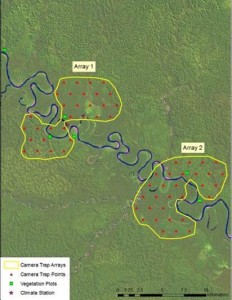By Patricia Álvarez-Loayza
Tropical Ecology Assessment and Monitoring (TEAM Network)
The idea behind TEAM is deceptively simple: to measure and compare plants, terrestrial mammals, ground-dwelling birds and climate using a standard methodology in a range of tropical forests, from relatively pristine places to those most affected by people. TEAM currently operates in sixteen tropical forest sites across Africa, Asia and Latin America supporting a network of scientists committed to standardized methods of data collection to quantify how plants and animals respond to pressures such as climate change and human encroachment (from the TEAM web page).
TEAM Network Peru: A summary
Since 2011 during the months of June, July and August TEAM has conducted assessments of forests in floodplains and terra firme near the Cocha Cashu Biological Station and Pakitza Guard Post. Populations of terrestrial vertebrates, vegetation and climate were evaluated.
 The figure shows the location of the plots of trees evaluated in the months of August to September 2012, the 60 camera traps placed in the months of June, July and August 2012, and the location of the weather station.
The figure shows the location of the plots of trees evaluated in the months of August to September 2012, the 60 camera traps placed in the months of June, July and August 2012, and the location of the weather station.
In the censuses of 2011 and 2012 approximately 570 species of trees and lianas with a diameter at breast height of more than 10cm have been recorded. The total number of stems censused is 3721.
In 2011, 29 species of mammals and 14 species of birds were recorded. In 2012, 33 species of mammals, 24 species of birds and two species of reptiles were recorded. In 2013, 28 species of mammals and 23 species of birds were recorded. The animal population is an indicator of the state of conservation of Manu National Park. A comparison was made with other sites located in tropical forests where the TEAM project works; Manu is among the most pristine and preserved, being the place with the largest number of jaguars, pumas and tapirs.
To see wonderful images of mammals, captured by TEAM at Cocha Cashu, please click here.
